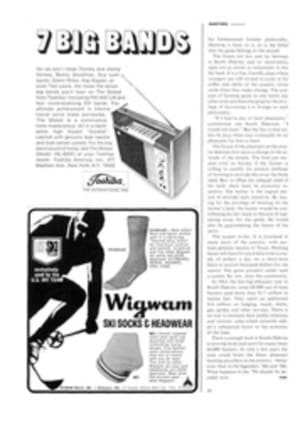
Plight of the people bird
From the number of guns that came off Flight 796 into Aberdeen, S. Dak. a couple of Friday nights ago, one might have thought the town was under siege. It was, in fact, being invaded—by a battalion of hunters. They came in on other flights, too—from both coasts, the South, the North and as far away as Mexico to spend opening weekend of the pheasant season tramping through wheat fields and alfalfa in search of the big bright-feathered birds. But, where this year a battalion ventured forth, 10 years ago an army would have roamed the state.
By almost any but South Dakota standards the pheasant shooting was not bad. Admittedly it has been better in other years but, even so, most hunters willing to walk and work for their birds managed to fill their limits. The trouble with South Dakotans is that they remember when pheasants were everywhere in numbers so thick that it was difficult to drive down a road without running over them. That was in the early '40s and '50s and as recently as 1963, when, depending upon which estimate you believe, there were anywhere from 11 to 30 million pheasants in the state. Today there are just over three million.
What happened and why has caused almost as much controversy in South Dakota as the war in Vietnam. The one fact in all the furor on which everyone agrees is that the birds have indeed declined. What keeps the arguments going into the night is whether the decline is the result of predators, pesticides, weather or lack of habitat.
The answer, of course, is that all have been factors, with lack of habitat being the most important. But the basic reason is not any of these. Nor is it a reason that very many people—-layman or expert—have considered or explored. The pheasant has declined on the prairie purely and simply because of the attitude of the residents toward the bird.
A pheasant is much more than a pretty creature to grace the roadsides and provide the hunter's sport. It is a valuable resource in the overall economy of this region. But few people have realistically appraised its role in their lives and community. Some have tried—notably members of the state Game Department and Pheasants Unlimited, a Sioux Falls organization dedicated to restoring the pheasant to its former peaks—but most efforts at convincing others have failed. The pheasant should and could be as important a commodity in South Dakota as wheat and white-face cattle. That it is not, in this era of enlightened game management and increased leisure, is indefensible.
No game bird imported into the U.S. has bred as successfully as the Chinese ringneck pheasant. The bird has been here almost 100 years and in that time has spread through 34 states. It is a people bird, prospering with cultivation rather than wilderness. Diversified farming and pheasants go hand in hand.
In the '40s pheasants were so numerous in the Dakotas that a single coolie or bottom might produce as many as 500 birds. Most farms were rich with shelter areas then. With slow, old-fashioned equipment and many young men away at war, today's "clean" farming was not possible—and the birds thrived. When the war ended, farming began to change. Equipment improved, the men returned and the cover began to go. So did the birds.
But in 1956 there was a reprieve. Soil banks were established throughout the grain belts, providing a form of subsidy for the farmer and lebensraum for the pheasant. Under the soil bank program the Federal Government remunerated the farmer for not farming a portion of his land over a five-to 10-year period. Such "retired" land nurtured weed and sweet clover, sunflower and bromegrass. The land also grew lush with pheasants. The abundance of food, nesting and winter cover on soil-bank land produced birds in phenomenal numbers. By the late '50s the pheasant population had increased spectacularly throughout the prairie.
After the soil-bank era all the land was turned back to cultivation, and "progress" came to the prairie It came in the form of even more improved machines, one of which could do jobs in a day that previously took several machines many days to perform. Such equipment drastically changed the agricultural pattern of the area. Brush stands, draws, shelter belts all disappeared as modern methods and equipment enabled the farmer to utilize even his most marginal acres. Potholes and sloughs were drained for crops. Fields once left in stubble until spring were fall-plowed. As farming intensified, most cover disappeared. There was no place for the pheasant to hide.
In a given year pheasant mortality is 70%. Under normal conditions the 30% carryover is more than enough to both replenish the loss and provide a healthy increase. Even under adverse conditions—drought, flood, severe snows—it is generally enough to pull the population through to a better year. Pheasants recover from such temporary setbacks remarkably well. A single cock with a harem of 10 hens, for example, can produce as many as 75 birds in a season. At even half that rate of reproduction, a badly decimated population can rapidly renew itself. But there must be adequate cover.
Research Biologist Larry Fredrickson of the South Dakota Department of Game, who has studied pheasants for the past several years, recently looked through some slides taken in Brookings County in 1959. "I had forgotten what the area looked like 10 years ago," he says. "It was a literal jungle. But then the sloughs were drained, the ditches were mowed, the weed patches cleared. One look at the changes in the land 10 years have made and it's obvious what has happened to the pheasants."
It has not, unfortunately, been obvious to the farmer. Nor has he had the vision to see that beyond the wheat and the rye and the cattle his most valuable crop might well be the pheasant. The farmer has not been alone in failing to recognize the pheasant for what it really is—a highly marketable resource to be cultivated. Most South Dakotans share his blind spot, just as they share his fundamental frontier philosophy. Hunting is basic to it, as is the belief that the game belongs to the people.
The fences are few and far between in South Dakota, and NO TRESPASSING signs are as scarce as mountains in this flat land. It is a free, friendly place where strangers are still invited to come in for coffee and clerks in the country stores smile when they make change. The concept of farming game as one farms any other crop and then charging for the privilege of harvesting it is foreign to such philosophy.
"If I had to pay to hunt pheasants," commented one South Dakotan, "I would not hunt." But the fact is that unless he pays there may eventually be no pheasants for him to hunt.
The future of the pheasant on the prairie depends first upon a change in the attitude of the people. The bird can surpass even its heyday if the farmer is willing to modify his present methods of farming to provide the cover the birds need. But, to offset the reduced yield of his land, there must be economic incentive. The hunter is the logical person to provide such incentive. By paying for the privilege of hunting on the farmer's land, the hunter would be contributing his fair share to the cost of supplying cover for the game. He would also be guaranteeing the future of his sport.
The system works. It is practiced in many parts of the country, with perhaps greatest success in Texas. Hunting leases sell there for anywhere from a couple of dollars a day on a short-term basis to several thousand dollars for the season. The game prospers under such a system. So, too, does the community.
In 1963, the last big pheasant year in South Dakota, some 68,000 out-of-state hunters paid more than $1.7 million in license fees. They spent an additional $14 million on lodging, meals, shells, gas, guides and other services. There is no way to estimate their public-relations and tourism value which certainly added a substantial boost to the economy of the state.
There is enough land in South Dakota to provide birds and sport for many times 68,000 hunters. In only a few years the state could boast the finest pheasant hunting anywhere in the country—better even than in the legendary '40s and '50s. What happens in the '70s should be decided now.

